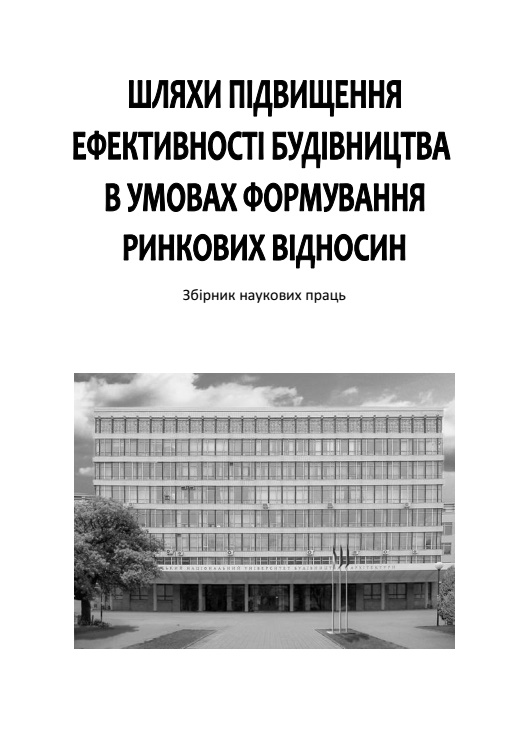Scientific and methodological substantiation of the design of state programs for the provision of temporary housing to the population affected by aggression RF
DOI:
https://doi.org/10.32347/2707-501x.2022.49(1).108-123Keywords:
design of state programs, temporary housing funds, imbalances in the primary housing market, integrated indicator of housing quality, price-quality ratio, principal factors method, Kohonen neural networkAbstract
The article is devoted to finding ways to solve the problem of providing housing for the population of Ukraine affected by the military conflict in Russia as soon as possible. The institutional preconditions and macroeconomic consequences of slowing down the implementation of the country's reconstruction projects are considered. An analysis of the proposals of leading economists set out in the Essay on the reconstruction of Ukraine. Three fundamental principles of ensuring effective recovery of the Ukrainian economy and reconstruction of damaged and destroyed housing are formulated and their essence is revealed. The author's proposals on the formation of temporary housing funds for internally displaced persons are substantiated and their contribution to restoring the balance of the primary housing market is proved. The causes of imbalances in the construction market of Ukraine are summarized. A methodical approach to the quantitative assessment of the price-quality ratio of housing in new buildings in Ukraine is proposed. 10 criteria were proposed to determine whether new homes meet market requirements. Within each of the criteria, gradation features were substantiated, which are measured in ordinal and nominal scales. A method for calculating the integrated quality indicator of facilities under construction based on data reduction by the method of main factors has been developed. The classification of housing supply in the primary real estate market according to the system of price - quality criteria, the methodological basis of which was neural network modeling using the Kohonen layer. Given the significance of the results obtained, the classification features that allow to separate those objects of market supply that have a low probability of sale in the next 6 to 12 months are justified. An easy-to-use algorithm for the formation of temporary housing funds for internally displaced persons from apartments-factors of market imbalances is proposed.
References
Бєлєнкова О.Ю., Титок В.В. Вплив розвитку інституційного середовища на конкуренцію у житловому будівництві. Український журнал прикладної економіки. 2020. Т. 5, №2. С. 214-221.
Данилишин Б. Про "план Маршалла для України" і не тільки. Який курс для післявоєнної відбудови економіки краще обрати Україні? Економічна правда. URL: https://www.epravda.com.ua/columns/2022/04/1/685066/ (дата звернення: 06.05.2022).
Боднарук І.Л. Особливості та проблеми реалізації програм державного молодіжного житлового кредитування в Україні. Український соціум. 2020. №3. С. 78-90.
Кобець М.П. Проблемні питання забезпечення права на житло внутрішньо переміщених осіб під час реалізації державних житлових програм. Наука і правоохорона. 2018. №1. С. 92-100.
Комітет Ради підтримує план економічного відновлення України з 9 пунктів. Укрінформ. URL: https://www.ukrinform.ua/rubric-economy/3473096-komitet-radi-pidtrimue-plan-ekonomicnogo-vidnovlenna-ukraini-z-9-punktiv.html (дата звернення: 06.05.2022).
Куц Я.В. Державні програми житлового будівництва як засіб модернізації сфери житлово-комунального господарства. Менеджер. 2017. №3. С. 137-145.
Мацапура О.В. Аналіз існуючого механізму макроекономічного регулювання державних закупівель. Шляхи підвищення ефективності будівництва в умовах формування ринкових відносин. 2019. Вип. 42. С. 132–137.
Мацапура О.В. Компаративна діагностика областей України за показниками тендерної активності учасників. Управління розвитком складних систем. 2019. Вип. 40. С. 169-173.
Мерзляк А.В., Кучин Б.С. Державні житлові програми як інструмент соціального захисту населення. Право та державне управління. 2016. № 2. С. 46-52.
Приймак А.М., Приймак І.М. Реалізація державних житлових програм як дієвий механізм удосконалення державної житлової політики (на прикладі Житомирської області). Державне управління: удосконалення та розвиток. 2019. № 10. URL: http://nbuv.gov.ua/UJRN/Duur_2019_10_11 (дата звернення: 06.05.2022).
Програма забезпечення житлом внутрішньо переміщених осіб. Збірка модельних документів для органів місцевої влади. БО «Благодійний фонд «Право на захист», Український фонд соціальних інвестицій. URL: https://r2p.org.ua/wp-content/uploads/2020/10/ufsi_modelni-programy_fin.pdf (дата звернення: 06.05.2022).
Ціни на новобудови / Портал нерухомості Lun.ua. URL: https://novostroyki.lun.ua/uk/ (дата звернення: 05.07.2019).
Шапошнікова І.О. Кластерний аналіз первинного ринку житлової нерухомості України: просторовий розріз. Науковий погляд: економіка та управління. 2019. №1(63). С.59–67. DOI: https://doi.org/10.32836/2521-666X/2019-1-63-8
Ціни на новобудови / Портал нерухомості Domik.ua. URL: http://domik.ua/nedvizhimost/ceny-kiev.html (дата звернення: 05.07.2019).
A Blueprint For The Reconstruction Of Ukraine. Centre for Economic Policy Research. URL: https://cepr.org/sites/default/files/news/BlueprintReconstructionUkraine.pdf.
Downloads
Published
How to Cite
Issue
Section
License

This work is licensed under a Creative Commons Attribution 4.0 International License.
Authors who publish with this journal agree to the following terms:
- Authors retain copyright and grant the journal right of first publication with the work simultaneously licensed under a Creative Commons Attribution License that allows others to share the work with an acknowledgement of the work's authorship and initial publication in this journal.
- Authors are able to enter into separate, additional contractual arrangements for the non-exclusive distribution of the journal's published version of the work (e.g., post it to an institutional repository or publish it in a book), with an acknowledgement of its initial publication in this journal.
- Authors are permitted and encouraged to post their work online (e.g., in institutional repositories or on their website) prior to and during the submission process, as it can lead to productive exchanges, as well as earlier and greater citation of published work (See The Effect of Open Access).

